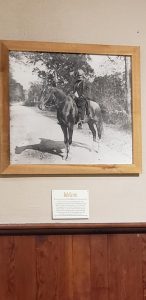Journey to Jubilee: From Enslavement to Freedom
By Monique Gooch
NASHVILLE, TN — In 1807, John Harding came from Virginia with his father to Tennessee. He bought 250 acres of land from Daniel A. Dunham which today is the Belle Meade Plantation which has two tours available _ the Journey to Jubilee which focuses on enslavement and freedom of African Americans, and the Mansion Tour which focuses primarily on the Harding-Jackson family and the horse industry. The tour can be with a tour guide, a segway tour or a self-guided tour.
The intention of the Journey to Jubilee tour is to take a deeper look into the lives of enslaved African-Americans and bring honor to the legacy and sacrifices of the individuals held in legal bondage on this property from 1807 to 1865 (emancipation).
The Belle Meade plantation housed the Harding-Jackson family. The plantation did not sell crops but focused solely on their horses. The enslaved jockeys were between 8 to 16 years old. Zachary Hodges, our tour guide, said that once, a
jockey was kicked in the ribs and was back to work within two weeks. That rib injury today would require at least a month’s rest.
In 1827, Rob Green tended to the horses when he was a young child. He grew up working with the horses and was an expert in taking care of the thoroughbred horses. He eventually became the main carriage driver for the Harding family. He was later nicknamed Uncle Bob Green. According to Hodges, the Harding family said, “He was a faithful and loyal servant.” After the Civil War, Green stayed on working yet he only made $30, while white jockeys were making double that. He died in 1906.
The horses that were bred on the property can all be traced back to the first-generation horse, yet there isn’t much history or records on the enslaved jockeys who tended to the horses.
There are also 16 slave cabins on the plantation. In 1950, five of them were destroyed in a fire. The cabins were completely destroyed in 1972 because they had deteriorated. A slave cabin from Cleveland Hall, originally from Donelson, was rebuilt in 1999 and brought to Belle Meade. The 16 slave cabins were on display to show off wealth to people and guests. Not many people in Tennessee had many slaves. The Harding family was the top 1 percent of slave owners at the time. with ownership of 136 enslaved men, women and children. There were about eight to 10 people in each of the 16 cabins.
The Harding family didn’t sell or buy slaves. They actually encouraged slave marriages. They felt that if they let slaves marry, and have children they would have slaves for the next generation.
The Emancipation Proclamation only freed slaves within certain states. Slaves in Tennessee had to wait until 1865 in order to be free. Of the 136 slaves on the plantation, 72 slaves stayed on and continued to work as contract laborers, while 68 slaves left. The 72 slaves that stayed made up about 17 families.
The tour lasted an hour and there is so much rich history at the Belle Meade plantation. There are stories about Susanna Carter a head domestic house slave, blacksmiths Ben and Ned who ran away and were never found, and Rueben Harris who eventually became the first African-American firefighter in America.
Hodges ended the tour by saying, “They [slaves] didn’t get a voice. We’re trying to construct their narrative.” The Belle Meade Plantation does just that. It gives them a voice; it brings it all to life. To sign up for a tour go to /https://visitbellemeade.com/history-tours/mansion-tour-admission/.


